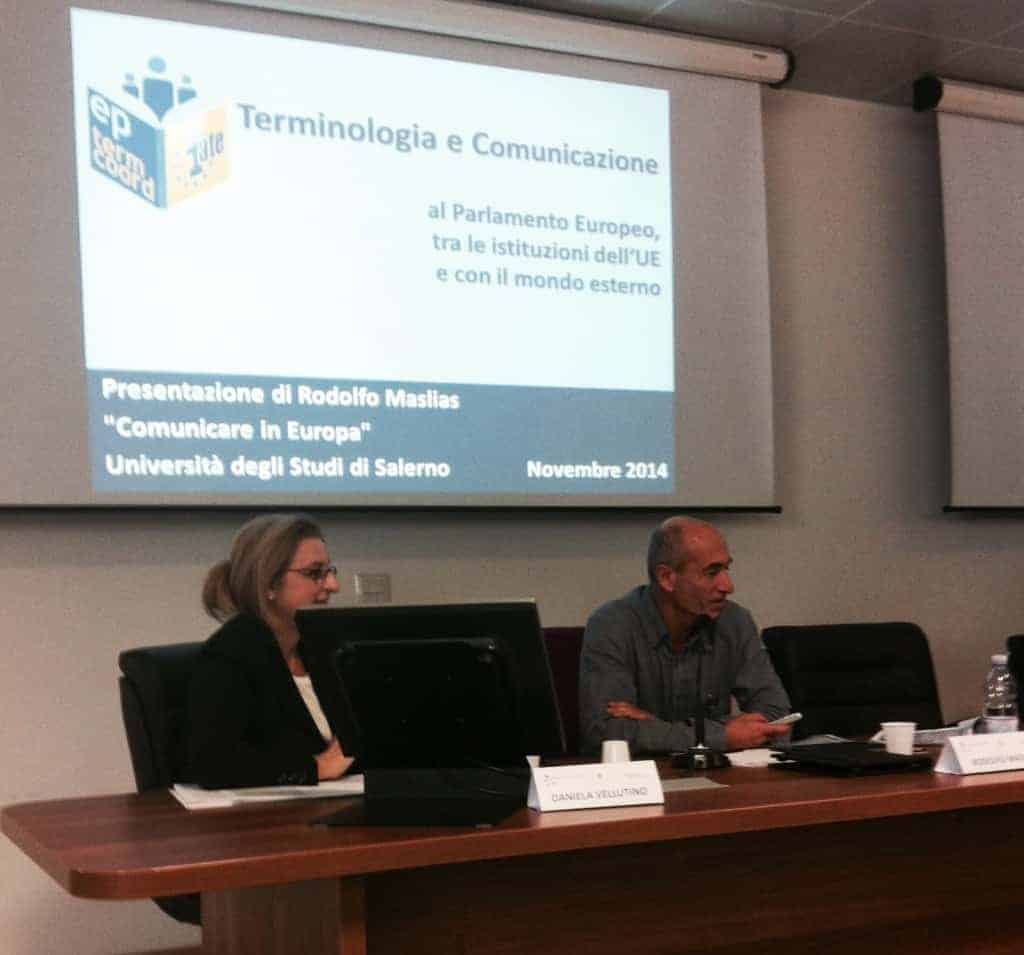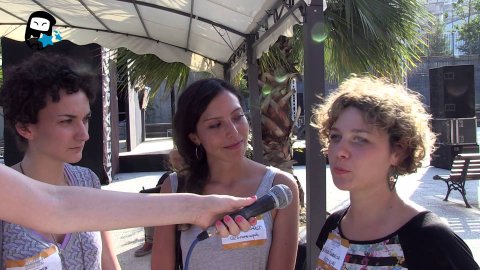
On Friday 7th November, the University of Salerno organised a conference under the title “Comunicare in Europa” and TermCoord was invited to present how much communication is today a need and a means for terminology and how communication is used in the framework of terminology management in the EU. The presentation of the Head of TermCoord, Rodolfo Maslias was made in Italian.

The conference started at 10 a.m., opened by the greetings of the Director of the Department of Political, Social and Communication Sciences , Annibale Elia , followed by an introduction to the main theme by the organizer of the conference, Daniela Vellutino, who underlined how important it is in the interests of growth and improvement, the good use of institutional terminology . Participants were invited to share ideas and content in real time on Twitter using the official hashtag of the initiative: #UECE14. The seminar was divided into two complementary sections, first was a theoretical introduction about “How institutional terms are born and managed”, coordinated by Maria Teresa Zanola (President Ass . I.Term and Realiter , Università del Sacro Cuore of Milan), and the second one concerned operational tools for achieving transparent terminology and involving more effectively the citizens, entiteled ” How to co mmunicate the opportunities of Europe 2020″ coordinated by Marco Esposito (journalist at Il Mattino, economist). The Head of the Italian translation department of the European Commission and President of the Network REI – Rete dell’ Eccelenza del Italiano, Italo Rubino made a general introduction on the multilingualism in the European Union and the importance of terminology in the legislative work of the EU. It was followed by TermCoord’s presentation that focused particularly on the cooperation with universities, the importance of IATE and its interinstitutional management. The final speech of the first part was given by Mara Giua, member of the Department for Development and Economic Cohesion of the Italian Government, who illustrated OpenCohesion , “An open government initiative in order to increase transparency in the use of public resources of cohesion policies , where data on the progress of each project are published and citizens are guided through the understanding process of information”. The second session of “Comunicare Europa ” opened with the intervention of Licia Corbolante , terminologist and editor of the blog terminologiaetc.it . Corbolante began with the concept of the “Curse of Knowledge”, or ” the difficulty of imagining that others do not know what we know well.” As a result, texts and documents difficult to understand are often created: “Typical manifestations are information and referrals taken for granted , the use of abstractions – familiar and routine to the writer, but not for those less experienced readers – and jargon, abbreviations, acronyms and terminology made for insiders, without definition or explanation”.
mmunicate the opportunities of Europe 2020″ coordinated by Marco Esposito (journalist at Il Mattino, economist). The Head of the Italian translation department of the European Commission and President of the Network REI – Rete dell’ Eccelenza del Italiano, Italo Rubino made a general introduction on the multilingualism in the European Union and the importance of terminology in the legislative work of the EU. It was followed by TermCoord’s presentation that focused particularly on the cooperation with universities, the importance of IATE and its interinstitutional management. The final speech of the first part was given by Mara Giua, member of the Department for Development and Economic Cohesion of the Italian Government, who illustrated OpenCohesion , “An open government initiative in order to increase transparency in the use of public resources of cohesion policies , where data on the progress of each project are published and citizens are guided through the understanding process of information”. The second session of “Comunicare Europa ” opened with the intervention of Licia Corbolante , terminologist and editor of the blog terminologiaetc.it . Corbolante began with the concept of the “Curse of Knowledge”, or ” the difficulty of imagining that others do not know what we know well.” As a result, texts and documents difficult to understand are often created: “Typical manifestations are information and referrals taken for granted , the use of abstractions – familiar and routine to the writer, but not for those less experienced readers – and jargon, abbreviations, acronyms and terminology made for insiders, without definition or explanation”.
Maria Pia Montoro, web content manager of some sites of the European Commission (for Intrasoft International) continued explaining what happens “behind the scenes” that is what word choices are made before translating an official document of the European Commission: just as if it were a “make-up artist” fix, many operations are done in order to make the institutional language clear and understandable to everyone. Mirko Pallera, co-founder of Ninja Marketing, delivered a speech along the following lines: “Behind the smoke and the mysticism of some terms always hides some sort of power. You cannot know how to spend EU funds unless you turn to a specialized broker”. Claudio Silvestri, a journalist of the “Rome” and deputy secretary of the Union of Journalists of Campania, closed the conference explaining how needed are those journalists capable of “communicating Europe to citizens” and making it understandable to all subjects of vital importance in the name of the motto “more journalism equals more democracy”.
All presentations of the conference will be uploaded on its website.
Watch the video of the interviews:

